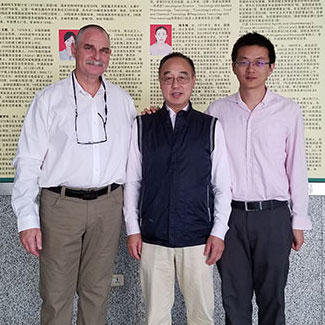November 14, 2017
Pharmacology and toxicology scientist gives presentations in China on drug residues in food animals and computational modeling

Multitasking is an understatement for describing recent activities for Zhoumeng Lin, assistant professor of pharmacology and toxicology in the College of Veterinary Medicine. He was invited to give multiple presentations in China, while also meeting with a group of renowned scientists in the field of veterinary pharmacology and toxicology.
Lin serves on the faculty for the Institute of Computational Comparative Medicine and anatomy and physiology department. He also is the principal investigator and regional director of the Midwest Regional Center for the Food Animal Residue Avoidance Databank program at Kansas State University.
"My research focuses on applying computational modeling technologies to address problems in drug tissue residues, withdrawal time, food safety, animal health, nanomaterial tissue distribution, cancer nanomedicine and nanomaterial risk assessment," Lin said. "We employ computational modeling methods that include physiologically based pharmacokinetic, or PBPK, modeling, traditional pharmacokinetic modeling, population pharmacokinetic modeling, and pharmacokinetic/pharmacodynamic modeling."
He was recently invited to attend the 14th Conference on Veterinary Pharmacology and Toxicology from Oct. 17-20 in Qingdao, China.
"I gave two presentations in the meeting, including a focused presentation titled 'Development of a Population Physiologically Based Pharmacokinetic Model for Penicillin G in Swine, Beef Cattle, and Dairy Cows for Food Safety Assessment' and a keynote presentation titled 'Application of the Food Animal Residue Avoidance Databank, or FARAD, in animal health, human food safety, and animal drug development,'" Lin said.
He also gave an introduction of the American Academy of Veterinary Pharmacology and Therapeutics on behalf of its past president, Ronette Gehring, who was formerly a faculty member at K-State. Lin's laboratory member, Dongping Zeng, gave an oral presentation titled "A physiologically based pharmacokinetic model for T-2 toxin in Chicken."
Lin said the other invited speakers include Pierre-Louis Toutain, professor in veterinary pharmacology at the Royal Veterinary College in London, England, who also serves as president of the European College of Veterinary Pharmacology and Toxicology; Stephen Page, professor in veterinary pharmacology and toxicology at the University of Sydney, Australia; Arturo Anadon, professor in toxicology and pharmacology at the Complutense University of Madrid, Spain; and Eran Lavy, professor in veterinary pharmacology at the Hebrew University of Jerusalem, Rehovot, Israel.
"I was also invited to give a series of lectures on PBPK modeling to the Department of Veterinary Pharmacology and Toxicology at Huazhong Agricultural University in Wuhan, China," Lin said.
His lectures were on "Introduction of PBPK modeling," "PBPK model development — mathematical description of absorption and distribution," "PBPK model development — mathematical description of metabolism and elimination," and "PBPK model calibration, evaluation and analysis."
"This trip provided an excellent opportunity to discuss potential collaborative projects on drug tissue residues, withdrawal time estimation, PBPK modeling, and food safety with the hosts, Dr. Zonghui Yuan and Dr. Lingli Huang," Lin said.
Yuan, a world-renowned veterinary pharmacologist, is professor and head of the department of veterinary pharmacology and toxicology at Huazhong Agricultural University, Wuhan, China. He also is an elected member of the Royal Academy of Veterinary Sciences of Spain. Huang, who was a visiting scholar here at the ICCM, is now an associate professor and associate department head for the department of veterinary pharmacology and toxicology at Huazhong Agricultural University, Wuhan, China. These collaborative projects are in line with K-State's mission of Food Animal Residue Avoidance Databank.
Lin said he recently received a USDA-NIFA grant to support the mission of national FARAD program, which is to provide science-based expert advice and quantitative tools to help mitigate unsafe chemical residues in products derived from food animals. Another recent grant is from the NIH/NIBIB for "Physiologically based pharmacokinetic modeling and analysis of nanoparticle delivery to tumors." Lin said the goal of this project is to construct a general physiologically based pharmacokinetic model for nanoparticles in tumor-bearing animals using traditional approaches. He also received a 2017-2018 K-State CVM Success For Young Investigators Award to support his computational nanomedicine research. In addition to his research activities, Lin teaches a graduate level online course in PBPK modeling through K-State Global Campus.
